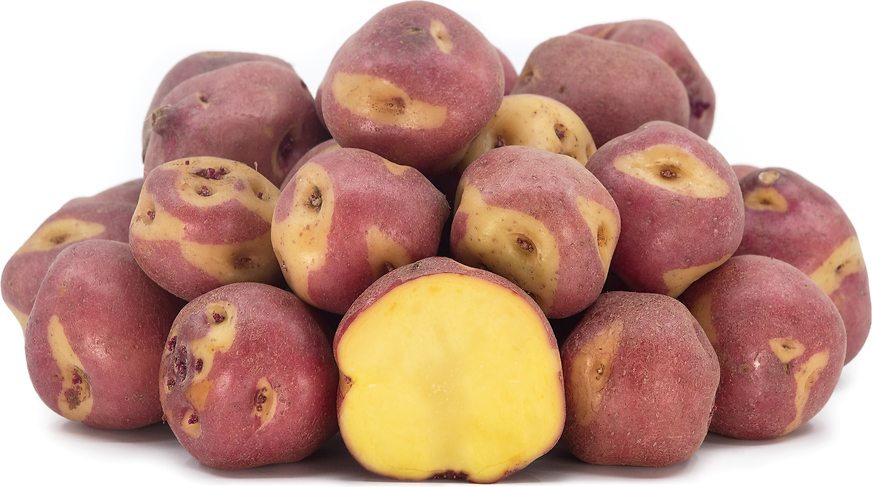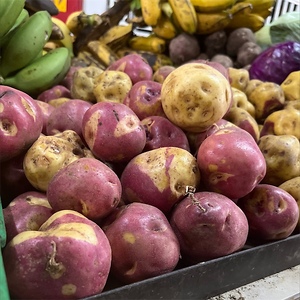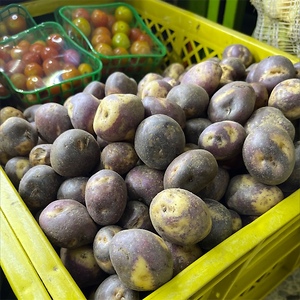


Mambera Potatoes
Estimated Inventory, 1 Lb : 0
Description/Taste
Mambera potatoes are small to medium-sized tubers with an irregular, round to oval shape. The skin is semi-thin, smooth, and firm with a red base and yellow spots, generally centered around the eyes. The surface also bears many medium to deep-set eyes embedded into the skin, giving the tuber a lumpy, lopsided appearance. Underneath the skin, the flesh is yellow, dense, slippery, and fine-grained. Mambera potatoes are low in water and high in starch, developing a floury consistency. When cooked, the tubers have a fluffy and dry texture with a mild, earthy, and nutty flavor.
Seasons/Availability
Mambera potatoes are available year-round in South America.
Current Facts
Mambera potatoes, botanically classified as Solanum tuberosum, are an ancient Andean variety belonging to the Solanaceae or nightshade family. The bi-colored tubers are grown throughout the Andean highlands and are one of the most popular native varieties cultivated in Colombia. Potatoes have been developed among indigenous peoples in the Andean highlands for thousands of years, and at one time, there were over 800 different varieties grown in Colombia. Within these villages, Mambera potatoes were traditionally sown in succession over plots of land known as microspaces, and many of these growth sites were monitored and planted according to the cycle of the moon, a favored cultivation method. Mambera potatoes are one of the few varieties that have been preserved over time and are still cultivated in the modern-day. The variety is not commercially produced due to its disease susceptibility, but Mambera potatoes are sold at fresh markets in regions where the tubers are locally grown, utilized in a wide variety of culinary applications.
Nutritional Value
Mambera potatoes are an excellent source of vitamin C to strengthen the immune system, potassium to balance fluid levels within the body, and vitamin B6 to monitor proper cell functioning. The tubers are also a good source of fiber to regulate the digestive tract, manganese to maintain healthy metabolic functioning, and contain lower amounts of folate, phosphorus, and magnesium.
Applications
Mambera potatoes are best suited for cooked applications, including roasting, frying, simmering, and baking. The potato can be consumed with or without the skin, and the flesh’s fluffy consistency when cooked absorbs accompanying flavors, giving dishes a creamy texture. Mambera potatoes can be quartered and used to flavor soups and stews, baked and served with toppings, or sliced and layered into casseroles and gratins. The tubers can also be cooked and mashed, pureed as a side dish, or cut into wedges and fried for a crisp exterior. In Colombia, Mambera potatoes are incorporated into traditional recipes such as papas rellenas, a snack or breakfast dish of stuffed potatoes with ground meat, cheeses, and spices, or they are used in arroz atollado, which is a pork risotto. Mambera potatoes pair well with meats such as poultry, beef, pork, and fish, corn, pumpkin, tomatoes, bell pepper, avocado, garlic, herbs such as cilantro, oregano, parsley, and thyme, rice, and beans. Whole, unwashed Mambera potatoes will keep for a couple of weeks when stored in a cool, dry, and dark place.
Ethnic/Cultural Info
Native potato varieties, including Mambera potatoes, are featured on the menu of 60 Nativas, a restaurant in Bogota, Colombia, centered around indigenous tubers. Chef Oscar Gonzalez created the restaurant to showcase native potato varieties and honor their diverse flavors, textures, and colors. Gonzalez closely partners with twelve families who grow indigenous tubers, and since the restaurant’s opening, over 60 varieties have been incorporated into the menu. Native potato varieties are rapidly declining in Colombia due to the introduction of newer cultivars and streamlined commercial production, significantly limiting the varieties being developed, but Gonzalez strives to educate his guests on the importance of unmodified, uniquely shaped varieties. On the 60 Nativas menu, potatoes are prepared in many different ways, including frying, roasting, and baking, and Mambera potatoes are popularly cooked into French fries. Mambera potatoes are also simmered into ajiaco, a Colombian soup made from three different types of potatoes, corn, chicken, and spices. Ajiaco is a beloved dish within Bogota, and Mambera potatoes provide a smooth, creamy texture and infuse a mild, nutty flavor into the soup.
Geography/History
Potatoes are native to South America, specifically the Bolivian-Peruvian highlands, and have been cultivated for thousands of years. In the early ages, potatoes were transported across the Northern Andes Mountains and were spread among indigenous peoples, where many new varieties were bred over time. Mambera potatoes are found in the paramos, a unique ecosystem within the Andean highlands stretching across Ecuador and Colombia. The variety is primarily grown in the Cauca Valley, a department in Western Colombia, and is also cultivated in the departments of Narino, Antioquia, and Boyaca. Today Mambera potatoes are sold through local markets and are also grown on a small scale through home gardens in Colombia and Ecuador.
Recipe Ideas
Recipes that include Mambera Potatoes. One









